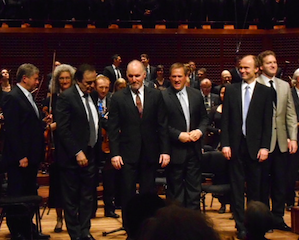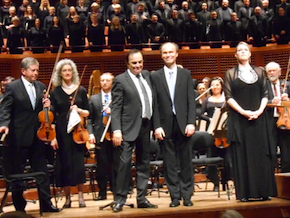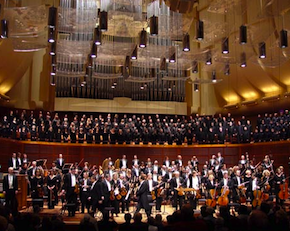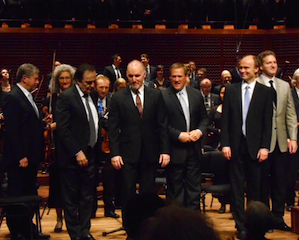
Photos by Janos Gereben
It was a bittersweet affair in Davies Symphony Hall on Sunday at the last performance of the Poulenc Stabat Mater and Berlioz Te Deum: a tremendous concert, but no more opportunity to recommend and repeat.
In fact, we will not have huge, majestic choral events until the SFS Beethoven Missa solemnis in May and September's San Francisco Opera production of Boito's Mephistopheles.
The orchestra, Ragnar Bohlin's SFS Chorus, Kevin Fox's Pacific Boychoir, superb (and unlisted) organist Jonathan Dimmock, soprano Erin Wall, and tenor Paul Groves all well deserved the tumultuous ovation, but special recognition should go to Charles Dutoit, who mastered both scores exceptionally well.
What at first appeared a slow tempo in the Poulenc turned out to be exactly right in order to let the music breathe; he sustained the momentum of Berlioz' heaven-storming sound flawlessly, performance after performance.

When the genuinely courteous and self-effacing conductor went around the orchestra for the final curtain call to shake hands with musicians in a wide circle, I wish that he had made his way all the way up to the brass, which performed in an extraordinary way, especially in the Berlioz.
The concerts are over, appreciated by all listeners (even the usually more critical and less pious Michael Strickland) but much remains besides the memories.
Even after the fact, don't miss James Keller's essay on Poulenc in the SFS program.
It begins with what is known in the trade as an "inviting lead":

Photo by Michael Strickland
"For Francis Poulenc, the year 1963 began in unremarkable fashion, but already by the end of January he surprised everyone by dying ..."
I've been trying to figure out the secret of the Poulenc Sound, wondering if there is a Poulenc Chord (a la Tristan), but the closest — and still not satisfactory — answer is in Ned Rorem's Setting the Tone, with this recipe:
Take Chopin's dominant sevenths, Ravel's major sevenths, Fauré's plain triads, Debussy's minor ninths, Mussorgsky's augmented fourths. Filter these through Satie by way of the added sixth chords of vaudeville (which the French call Le Music Hall), blend in a pint of Couperin to a quart of Stravinsky, and you get the harmony of Poulenc.
Another suggestion — "unsettled spacing of chords glinting with major 7ths" — appears in an intriguing Poulenc essay by pianist Stephen Hough.

